Retinal Projection Displays: The Next Frontier in Personal Computing
In the ever-evolving landscape of personal computing, a groundbreaking technology is poised to revolutionize how we interact with digital content. Retinal projection displays, once confined to the realm of science fiction, are now emerging as a viable alternative to traditional screens. This cutting-edge technology promises to deliver an immersive visual experience by projecting images directly onto the user's retina, potentially transforming everything from smartphones to wearable devices.

The Science Behind Retinal Projection
Retinal projection technology relies on a sophisticated interplay of optics, lasers, and eye-tracking systems. At its core, the system uses miniature lasers—typically red, green, and blue—to create a full-color image. These lasers are precisely controlled to scan across the retina in a pattern that mimics how we naturally perceive images, tricking our brains into seeing a complete picture.
One of the key challenges in developing this technology has been creating a system that can adjust to the constant micro-movements of the human eye. Advanced eye-tracking algorithms work in real-time to ensure that the projected image remains stable and in focus, regardless of where the user is looking.
From Military Origins to Consumer Applications
The concept of retinal projection isn’t entirely new. It has its roots in military applications, where it was initially developed for fighter pilot helmet displays. However, recent advancements in miniaturization and power efficiency have opened up possibilities for consumer use.
Several companies are now racing to bring retinal projection displays to the mass market. While specific pricing details are still under wraps, industry analysts estimate that early consumer devices could range from $500 to $1,500, depending on their capabilities and form factors.
Advantages Over Traditional Displays
Retinal projection offers several distinct advantages over conventional screen technology. Perhaps most notably, it allows for an incredibly wide field of view without the bulk associated with large physical displays. This could be particularly game-changing for augmented reality (AR) applications, where a seamless blend between digital content and the real world is crucial.
Moreover, retinal projection displays consume significantly less power than traditional screens, potentially extending battery life in portable devices. They also promise superior visibility in bright sunlight, a common pain point for current smartphone and tablet users.
Potential Applications and Market Impact
The potential applications for retinal projection displays are vast and varied. In the mobile space, we could see ultra-compact smartphones that project full-sized interfaces. Wearable devices like smart glasses could become more discreet and comfortable while offering expansive virtual displays.
Beyond personal computing, the technology could find its way into automotive heads-up displays, providing drivers with crucial information without taking their eyes off the road. In professional settings, it could enable new forms of 3D modeling and data visualization.
Market researchers predict that the retinal projection display market could reach $4.5 billion by 2027, with a compound annual growth rate of over 20%. This growth is expected to be driven by early adoption in niche professional markets before expanding into consumer electronics.
Challenges and Ethical Considerations
Despite its promise, retinal projection technology faces several hurdles before widespread adoption. Safety concerns regarding long-term exposure to laser light must be thoroughly addressed. Additionally, the technology needs to overcome potential issues with user comfort and adaptation, as some early testers have reported mild disorientation or eye strain.
There are also ethical considerations to grapple with. As these devices become more prevalent, questions about privacy and data security will come to the forefront. How can we ensure that the visual information being projected is secure and not vulnerable to interception or manipulation?
The Road Ahead
As retinal projection displays continue to evolve, we can expect to see rapid advancements in both the technology itself and its applications. Ongoing research is focused on improving resolution, expanding the color gamut, and further miniaturizing the necessary components.
While it may be several years before retinal projection displays become commonplace in consumer devices, the technology’s potential to reshape our digital interactions is undeniable. As we move towards a future where our visual interfaces are no longer constrained by physical screens, the possibilities for innovation in personal computing are boundless.
The journey of retinal projection displays from sci-fi concept to market reality is a testament to the relentless pace of technological progress. As this technology matures, it promises to open up new frontiers in how we perceive and interact with digital information, potentially ushering in a new era of personal computing that seamlessly blends the virtual and physical worlds.





